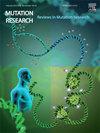In silico report on five high-risk protein C pathogenic variants: G403R, P405S, S421N, C238S, and I243T
IF 1.9
4区 医学
Q4 BIOTECHNOLOGY & APPLIED MICROBIOLOGY
Mutation Research-Fundamental and Molecular Mechanisms of Mutagenesis
Pub Date : 2025-05-17
DOI:10.1016/j.mrfmmm.2025.111907
引用次数: 0
Abstract
In this study, we propose reclassification of 5 out of 16 PROC VUS (variants of uncertain significance): C238S, I243T, G403R, P405S, and S421N, as pathogenic variants, associated with thrombophilia due to PROC deficiency. The obtained results are based on in silico analysis, which enables a detailed assessment of variants’ impact, despite limited clinical evidence. In particular, the G403R substitution, next to the S402-active site, is expected to reduce the flexibility of the local coil domain, affecting the catalytic activity of serine protease. The P405S substitution may imply B-factor gain (P = 0.24; p-value=0.040). On the other hand, the S421N variant causes phosphorylation site disruption at S421, which serves as a target for CK2 phosphorylation. C238S substitution alters metal binding, while the I243T variant may alter transmembrane properties (P = 0.27, P-value=0.00071). All five PROC variants hold promise as diagnostic markers for protein C deficiency and may also serve as potential drug targets for therapeutic intervention.
五种高危蛋白C致病变异:G403R、P405S、S421N、C238S和I243T的计算机报告
在这项研究中,我们提出将16个PROC VUS(意义不确定的变体)中的5个重新分类为致病变体,即C238S、I243T、G403R、P405S和S421N,这些变体与PROC缺乏导致的血栓形成相关。获得的结果基于计算机分析,尽管临床证据有限,但可以对变异的影响进行详细评估。特别是在s402活性位点旁边的G403R取代,预计会降低局部线圈结构域的柔韧性,影响丝氨酸蛋白酶的催化活性。P405S取代可能意味着b因子增益(P = 0.24;假定值= 0.040)。另一方面,S421N变异导致S421磷酸化位点破坏,S421作为CK2磷酸化的靶点。C238S取代改变金属结合,而I243T变体可能改变跨膜性质(P = 0.27,P值=0.00071)。所有五种PROC变体都有望作为蛋白C缺乏症的诊断标记物,也可能作为治疗干预的潜在药物靶点。
本文章由计算机程序翻译,如有差异,请以英文原文为准。
求助全文
约1分钟内获得全文
求助全文
来源期刊
CiteScore
4.90
自引率
0.00%
发文量
24
审稿时长
51 days
期刊介绍:
Mutation Research (MR) provides a platform for publishing all aspects of DNA mutations and epimutations, from basic evolutionary aspects to translational applications in genetic and epigenetic diagnostics and therapy. Mutations are defined as all possible alterations in DNA sequence and sequence organization, from point mutations to genome structural variation, chromosomal aberrations and aneuploidy. Epimutations are defined as alterations in the epigenome, i.e., changes in DNA methylation, histone modification and small regulatory RNAs.
MR publishes articles in the following areas:
Of special interest are basic mechanisms through which DNA damage and mutations impact development and differentiation, stem cell biology and cell fate in general, including various forms of cell death and cellular senescence.
The study of genome instability in human molecular epidemiology and in relation to complex phenotypes, such as human disease, is considered a growing area of importance.
Mechanisms of (epi)mutation induction, for example, during DNA repair, replication or recombination; novel methods of (epi)mutation detection, with a focus on ultra-high-throughput sequencing.
Landscape of somatic mutations and epimutations in cancer and aging.
Role of de novo mutations in human disease and aging; mutations in population genomics.
Interactions between mutations and epimutations.
The role of epimutations in chromatin structure and function.
Mitochondrial DNA mutations and their consequences in terms of human disease and aging.
Novel ways to generate mutations and epimutations in cell lines and animal models.

 求助内容:
求助内容: 应助结果提醒方式:
应助结果提醒方式:


